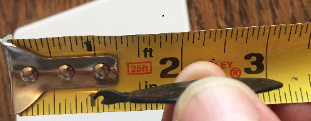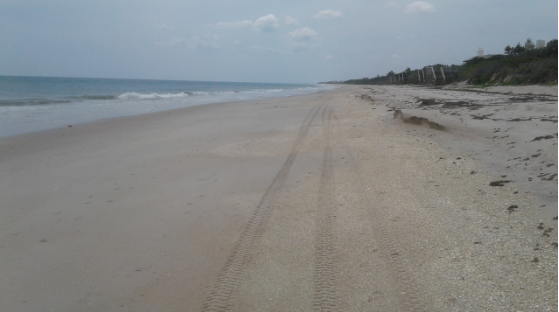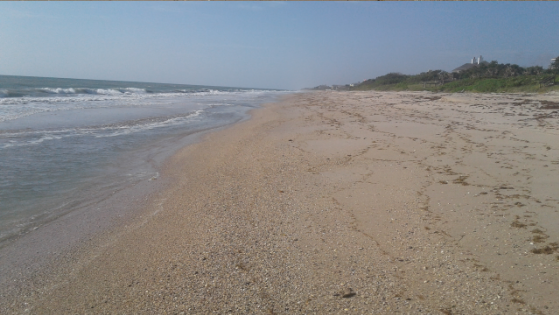Written by the TreasureGuide for the exclusive use of the TreasureBeachesReport.blogspot.com.
 |
| 103 Gram Meteorite Found by SuperRick with Metal Detector Photo by SuperRick. |
Rick thought the one above (which was not found in Florida) was a "cold" meteorite, which means that it was not found in a known meteorite area, but then another fellow said he found one in the same area. When it comes to meterorites, a "cold find" is a find made where none had been found before. It is something like finding a shipwreck cob where there is no known shipwreck and where cobs have not been found before. That is very different from hunting on a well known shipwreck beach. It makes the odds much bigger against you, and it makes the find potentially very significant.
Here is the link to SuperRick's YouTube video about the meterorite find.
https://www.youtube.com/watch?v=5vva01ePYkg&t=14s
You might remember the big meteorite auction that I mentioned not long ago. Some meteorites can be worth a lot.
---
Here is an excellent scientific article on shipwreck sinkings and the formation of the debris field.
On the Hydromechanics of Vessels and Debris Fields During Sinking Events by Sean Kery.
Here is the abstract.
When a vessel leaves the surface and plunges to the seabed, a lot of things can happen that will affect its orientation and position on the seabed and the creation and distribution of the debris field. Crushing and catastrophic implosion due to the rapidly increasing hydrostatic pressure has been noted on portions of many wrecks. Extensive damage due to bottom impact and subsequent motions have also been observed and documented. This paper describes the successful numerical modeling of the sinking of several historic vessels. One was in deep water and another in shallow water. In both cases it was possible for the simulation to replicate important details of the debris field. Further work is planned to help explain some of the taphonomy observed as the wreck decays over time as it is acted on by bottom currents, benthic storms and in the shallow case storm waves.
This is not light reading.
http://www.sname.org/HigherLogic/System/DownloadDocumentFile.ashx?DocumentFileKey=a7f10ad9-1b65-03ed-757b-7be8daa49310
When thinking about how a ship breaks up and debris gets distributed, here are a few types of damage and debris dispersion to consider as presented in the article.
Damage unrelated to the sinking which occurred over the vessels service life prior to the sinking
Damage which was causative in the sinking
Damage which occurred during progressive flooding
Damage which occurred in the water column on the way down including hydrostatic implosion, and unsecured objects falling off
Damage due to bottom impact, including collision damage leading to hydraulic outbursts 2
Debris dispersion due to objects which came off higher in the water column sinking at different rates through layered currents. Objects that fall slower are carried further by currents.
Debris dispersion due to the sinking microburst plume and hydraulic outburst plumes
Damage due to currents, waves, benthic storms, corrosion, and biodegradation in situ.
That gives you some idea of the type of information you will find in that article.
---
Depth is always the big question when it comes to metal detectors. People usually do an air test and report that X detector will detect a coin at Y inches. I've talked extensively about the limitation of air tests in the past and recommended some alternatives. That isn't what I want to talk about now.
The deepest seeking detector, no matter how depth is measured or defined, is not always the best detector for a particular job. There are a lot of factors to consider.
People often want the deepest seeking detector, but then use their "deep seeking detector" in a way that achieves much less than the best performance. The wrong sweep or settings can result in very poor performance. There can be a big difference between the potential depth and the actual depth in field conditions and actual use.
The main point I want to make right now is that depth isn't as important as you might think when hunting cobs on a beach. The vast majority of cobs I've found have been within and inch or two of the surface.
A few days ago, I provided a link to a video that showed a guy finding old silver coins on the surface without even using a metal detector. That was because he was looking in the right place. He was looking where coins had been exposed. The most important thing in my opinion, is looking in the right place - which are the places where things accumulate and remain near the surface. In those places they will be on the surface or very near the surface.
Besides eye-balling, another way to know when you are in the right type of place is by analyzing what is in the area, including junk. That is one reason I don't discriminate a lot. Junk gives you important information about how good the area is. Junk can be a good sign or a bad sign, depending upon the type of junk it is. Different types of junk will normally, on a beach, have a predictable relationship to good targets. Good targets will tend to be closer to junk targets that are in some ways similar to the "good" targets. Density is one of several characteristics to consider. Junk and other targets aren't randomly distributed. There are reasons they are where they are. There are enough unknowns and enough complexity to disguise some of the patterns though.
I've eye-balled cobs laying on the sand several times. And that was not back decades ago and it was not after any of the major hurricanes.
I'm not talking about cobs back in the dunes, where they will often be down a foot or so. I'm talking about beach cobs, which as you know, most often show up during periods of erosion.
A couple days ago I showed what appeared to be a seawall and discussed how coins can work down along a wall or other things. That is a little different situation too. Still they are not going to sink until the sand moves from the area. It can take a long time for them to sink very deep. But that was a special situation and not the type of thing I am talking about now. Coin traps are another matter that I'll talk about again some other time.
--
On the Treasure Coast we're still having smooth seas. The tides are more moderate.
Happy hunting,
TreasureGuide@comcast.net




































